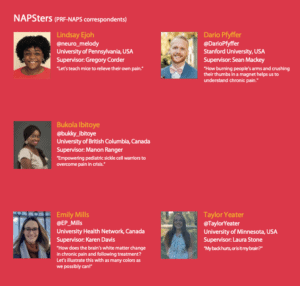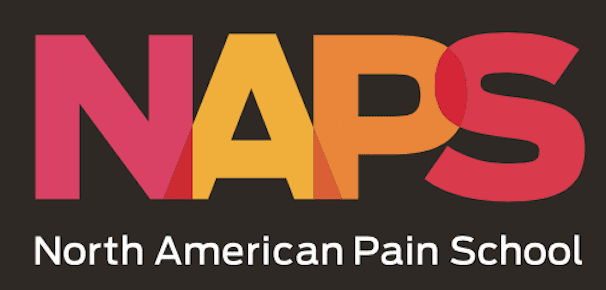NAPS Preview Blog Posts
I’m an Engineer, Not a Neuroscientist!
NAPS 2023 is almost here! I feel so lucky to have been invited to join this group of amazing pain researchers – and the experts we admire – to discuss important topics in our field.
Because I experience two chronic pain disorders, this year’s theme, “Pain and Time: Acute Pain, Chronic Pain, and Acute-to-Chronic Pain Transitioning,” hits home for me in a way that’s scary but exciting. It should be insightful to chat with our Patient Partners who also live with chronic pain, and other scientists who spend most of their days thinking about pain, too.
For my PhD work, I research pain from a “microscopic” perspective, studying the role of a specific brain circuit in pain. It will be refreshing to take a step back at NAPS and consider the broader therapeutic goals of the pain field – and better understand how much still needs to be accomplished. I’m sure I’ll learn a lot more about my pain and the role it plays in my life, too, empowering me to continue my career in pain research.
Stay tuned as I will be tweeting and writing daily blogs about my NAPS experiences on the Pain Research Forum, and vlogging on my TikTok/Instagram (@neuro_melody). I’m also excited to cover Anna Hood’s (University of Manchester, UK) session titled “Mechanisms of Injustice: Acute-to-Chronic Pain Transition for Pediatric Patients Living with Sickle Cell Disease.” I’ll also be conducting an interview with Frank Porreca (University of Arizona, USA), so look out for an interesting conversation about the translatability of basic science pain research!
Lindsay Ejoh is a PhD candidate at the University of Pennsylvania, USA. You can follow her on Twitter – @neuro_melody.
Lindsay is a fourth-year PhD candidate in the neuroscience program at the University of Pennsylvania, USA, where she studies neural circuits underlying pain and pain relief. She is especially interested in endorphins and other endogenous forms of pain relief. Outside of science, Lindsay is a musician and singer who is passionate about increasing underrepresented minority (URM) representation in STEM and using her skills to communicate complex science topics to the general public.
Once upon a time….
A damsel aspired to join the great North American Pain School. When the proclamation was made for new recruits, she sought the counsel of her mentors. With their blessings, she grabbed her writing tool, scribbled her application, and submitted it. After the passing of two full moons, she received a response. Anxiously, she looked at the letter and opened it….
Huzzah! She got into NAPS! When the time came, she grabbed her saddlebag, climbed onto her horse, and…. You get the gist.
I got into NAPS! Sorry to burst your bubble, but there is no prince in this story. Hopefully, there is a “happily ever after.”
Being a part of NAPS is a great privilege, and being a PRF-NAPS Correspondent is icing on the cake. As the days draw closer to NAPS, I am anxious, excited, enthusiastic, eager, and hopeful.
I’m anxious about interacting with the brilliant cohort of NAPSters and pain experts, and making a good impression to cement long-lasting professional connections.
I’m excited by the opportunity to meet and share ideas with scholars and experts from different backgrounds.
I’m enthusiastic about developing science communication skills through the PRF-NAPS Correspondents program (finally, my Twitter page will be resurrected).
I’m eager to learn about, “Pain and Time: Acute Pain, Chronic Pain, and Acute-to-Chronic Pain Transitioning,” which is crucial to my patient population of interest – those living with sickle cell disease.
I’m hopeful by June 23, my saddlebag will be filled with new connections, knowledge, and skills, and an intensified commitment to improving pain management in low-resource settings.
I’m looking forward to a memorable NAPS experience – one I’m hopeful I’ll recall 50 years from now.
Bukola Ibitoye is a PhD candidate at the University of British Columbia, Canada. You can follow her on Twitter – @bukky_ibitoye.
Bukola is a PhD candidate at the School of Nursing, University of British Columbia, Canada, and a lecturer at the University of Ilorin, Nigeria. She has a master’s degree in advanced nursing from the University of Nottingham, UK, and a bachelor’s degree in nursing from Kwame Nkrumah University of Science and Technology, Ghana. Her doctoral project is focused on developing and evaluating a web-based pain management toolkit, BoriZafi, to introduce Nigerian adolescents with sickle cell disease to various non-pharmacological interventions to improve their pain experience during vaso-occlusive crises. She has various publications in peer-reviewed journals and her research interests include pediatric pain and eHealth interventions.
After months of anticipation and organization, NAPS 2023 is finally upon us! There is certainly a mixture of nervous excitement amongst us trainees, fueled by several big questions: Who are our fellow NAPSters? What will be our biggest learning takeaways each day related to this year’s theme, “Pain and Time”? How long must we hold our downward dog pose during “Yoga with Ondine,” each morning?
Ever since the early days of my PhD training, I’ve wanted to become a NAPSter. NAPS alumni have spoken to me at length about the incredible learning and networking opportunities that NAPS offers each year. This year’s program looks set to deliver. I’m looking forward to the lectures by esteemed faculty and invited guests, the scientific and career-development workshops, the intimate lunchtime discussions, and the “Ask-a-Patient” sessions with our Patient Partners. We are certainly going to learn a tremendous amount and develop a valuable set of skills throughout the week (tips for giving better talks and handling academic negotiations are much appreciated, Jeff and Raj!).
Personally, one of the biggest draws of NAPS is the opportunity to connect with the pain research leaders of tomorrow. We come from diverse backgrounds and locations, but we are united by our common goal: To understand pain so that we can provide better solutions for people in pain. The bonds we forge at NAPS will likely be lifelong. To my fellow NAPS 2023 trainees, I am so excited to meet you!
Before I sign off, I must give a huge shout-out to the NAPS Executive Committee and Coordination Team, who have spent months putting together this exciting and diverse program. I think I speak for all NAPSters who are traveling from around the world to attend when I say, “We are beyond excited to get this show started!”
Emily Mills is a postdoctoral researcher at the Krembil Brain Institute, University Health Network, Toronto, Canada. You can follow her on Twitter – @EP_Mills.
Emily achieved her PhD in 2020 under the supervision of Luke Henderson and Flavia Di Pietro at the University of Sydney, Australia. In her PhD thesis, she used functional magnetic resonance imaging to investigate the function of the brainstem pain-modulation circuitry in individuals with chronic pain. She began a postdoctoral research position with Karen Davis at the Krembil Brain Institute in Toronto in June 2021. She currently uses diffusion-weighted imaging to examine white matter alterations in individuals with chronic neuropathic pain. During her postdoc, she’s also co-created the podcast Seeds of Science, which aims to showcase the diversity of research trainees across University Health Network in Toronto.
This title summarizes my feelings as I look forward to NAPS 2023 and its theme, “Pain and Time: Acute Pain, Chronic Pain, and Acute-to-Chronic Pain Transitioning.”
While I have the highest of expectations – full of thriving conversations with some of the world’s most renowned pain experts and rising junior pain researchers – I really don’t know what to expect. I am, however, very confident that my personal hopes of furthering pain science education and building my career network will be exceeded.
I’ve felt this internal “prickling” and eagerness during these last few weeks as NAPS approaches. I cannot wait to get involved in wonderful conversations and listen to ground-breaking presentations that are pushing the frontiers of pain research.
I’m thrilled to be working with Greg Carbonetti (@PainResForum) as a part of the PRF-NAPS Correspondents program, honing our science communication and writing skills. I also feel honored to get the chance to lead an interview with Rachael Bosma (University of Toronto, Canada – @rlbosma) and to write a recap on a session led by John Farrar (University of Pennsylvania, USA) titled, “How Do We Know When Pain Has Become Chronic? How the Measurement of Pain Affects the Acute-to-Chronic Pain Divide.”
Keep your eyes open for more updates on the different sessions, presentations, and activities during #NAPainSchool 2023 via my posts on Twitter – @DarioPfyffer.
Dario Pfyffer is a postdoctoral research scholar at Stanford University, California, USA.
Dario is a postdoctoral research scholar in Sean Mackey’s group within the Division of Pain Medicine at Stanford University School of Medicine, California, USA. Their work focuses on investigating mechanisms of aberrant pain processing and disrupted pain modulation in chronic pain patients (e.g., fibromyalgia) by means of innovative simultaneous brain and spinal cord neuroimaging. Aside from his research goal of developing neuroimaging biomarkers of chronic pain for long-term improvement of pain burden and patients’ quality of life, Dario is also an advocate of open science and engaging in science education and communication.
I’m an Engineer, Not a Neuroscientist!
Considering all the hype surrounding the North American Pain School, it’s no surprise that the very first thing I did as a postdoc was apply for NAPS 2023. I was elated to be invited and even more excited when I learned I’ll get to share my experience as a PRF-NAPS Correspondent.
Perhaps it is a bit unusual to begin a journey with a reflection; however, my pre-NAPS emotions and expectations feel similar to those before a program I participated in as a graduate student – the Marine Biological Laboratory Neurobiology Program (an incredible experience that I encourage trainees interested in neuroscience to check out!).
As I prepared to arrive for this program, I was anxiety ridden. As the course started, I felt an intense rush of imposter syndrome. What in the world had I signed up for? I was an engineer, not a neuroscientist! With each passing day, however, I felt more like I belonged. By the end of the program, I was feeling confident and energized, all while creating lasting connections with other scientists.
As I reflect, I see how programs like this neurobiology course and NAPS can catalyze personal and professional growth. Of course, I’m still the same eager trainee full of nervous energy and unsure of what to expect, but I can genuinely say I’m feeling excited and confident to participate in NAPS this year. So, to anyone who feels the pre-NAPS anxiety – you’ve got this, and I can’t wait to meet you!
That’s all for now! Follow me on Twitter to keep up with my NAPS adventure and more (@TaylorYeater). A sneak peak of what’s to come: Pictures and posts and podcasts (oh my!).
Taylor Yeater is a postdoctoral fellow at the University of Minnesota, USA.
Over the past decade, Taylor has trained in biomedical engineering at The Ohio State University, USA, and the University of Florida, USA. As a result, she’s become proficient in integrating medicinal knowledge with engineering approaches to create unique healthcare solutions. As a postdoctoral researcher at the University of Minnesota, USA, she’s approaching her research goals through this same integrative lens, aiming to understand the neurobiology of chronic musculoskeletal pain, and using that insight to advance non-pharmacological interventions for managing pain. Outside of research, she’s interested in community education and delighted to create content for PRF.
The 2023 PRF-NAPS Correspondents



